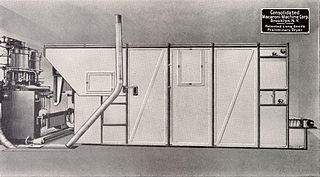
Pasta is a type of food typically made from an unleavened dough of wheat flour mixed with water or eggs, and formed into sheets or other shapes, then cooked by boiling or baking. Rice flour, or legumes such as beans or lentils, are sometimes used in place of wheat flour to yield a different taste and texture, or as a gluten-free alternative. Pasta is a staple food of Italian cuisine.

Spaghetti is a long, thin, solid, cylindrical pasta. It is a staple food of traditional Italian cuisine. Like other pasta, spaghetti is made of milled wheat, water, and sometimes enriched with vitamins and minerals. Italian spaghetti is typically made from durum-wheat semolina. Usually the pasta is white because refined flour is used, but whole wheat flour may be added. Spaghettoni is a thicker form of spaghetti, while spaghettini is a thinner form. Capellini is a very thin spaghetti, sometimes known colloquially as "angel hair pasta", while Vermicelli refers to intermediate widths, varying between the United States and Italy.

Kraft Dinner (KD) in Canada, Kraft Mac & Cheese in the United States, Australia and New Zealand, Mac and Cheese in the United Kingdom and internationally, is a nonperishable, packaged macaroni and cheese product. It is made by Kraft Foods Group and traditionally cardboard-boxed with dried macaroni pasta and a packet of processed cheese powder. It was introduced under the Kraft Dinner name simultaneously in both Canada and the U.S. in 1937. The brand is particularly popular with Canadians, who consume 55% more boxes per capita than Americans.

Macaroni and cheese is a dish of cooked macaroni pasta and a cheese sauce, most commonly cheddar sauce.

Chinese noodles vary widely according to the region of production, ingredients, shape or width, and manner of preparation. Noodles were invented in China, and are an essential ingredient and staple in Chinese cuisine. They are an important part of most regional cuisines within China, and other countries with sizable overseas Chinese populations.

The Flying Spaghetti Monster (FSM) is the deity of the Church of the Flying Spaghetti Monster, or Pastafarianism, a parodic new religious movement that promotes a light-hearted view of religion. It originated in opposition to the teaching of intelligent design in public schools in the United States. According to adherents, Pastafarianism is a "real, legitimate religion, as much as any other". It has received some limited recognition as such.

Spaghetti and meatballs is an Italian-American dish consisting of spaghetti, tomato sauce and meatballs.

Pizza snack rolls are a frozen food product consisting of bite-sized breaded pizza pockets with an interior of tomato sauce, imitation cheese and various pizza toppings. They are sold in a variety of flavors including cheese, pepperoni, sausage, supreme, multiple imitation cheeses, and mixed meats. Other flavors included hamburger, cheeseburger, ham and cheese, and combination. Pizza snack rolls are designed to be quickly cooked in the oven or microwave. The name "pizza rolls" is a trademark of General Mills, current owner of the original product.

Ebro Foods, S.A., formerly Ebro Puleva, is a Spanish food processing company. Ebro Foods is the world's largest producer of rice and the second biggest producer of pasta. The company's head office is in Madrid.

The National Pasta Association (NPA) is a trade association of professionals in the United States pasta industry. The NPA originally formed as The National Association of Macaroni and Noodle Manufacturers of America in 1904, making it one of the oldest trade associations in the United States.

A. Zerega's Sons, Inc. was a privately owned pasta company with plants in Fair Lawn, New Jersey and Lee's Summit, Missouri. The company was founded by Antoine Zerega in Brooklyn, New York in 1848 making it the first pasta company in the United States. Antoine's son Frank was a pasta maker for 83 years and served as the company's president. Both Zerega Avenue in the Bronx and the elevated train station on the New York City Subway's Pelham Line were named after Antoine. The company moved from Brooklyn at 28 Front Street to Fair Lawn in 1952.

V. La Rosa and Sons Macaroni Company was founded in 1914 by Vincenzo La Rosa, a Sicilian immigrant. The company eventually became one of the largest regional brands in the United States producing over 40 varieties of pasta.
Looney Tunes Meals were a line of frozen dinners released by Tyson Foods in 1990. They were based on the characters from the eponymous Warner Bros. cartoons and targeted primarily at children. The meals were discontinued in late 1993 because of declining sales.

The Demaco extruder is a pasta extruder built by Demaco in West Melbourne, Florida, United States. It is the first pasta extruder ever built for USDA sanitary food plants. Its design allowed food producers to use an extruder directly in fresh, frozen and canning factories.

Dry pasta lines are machines that make dry pasta products such as spaghetti or penne on a commercial scale, used for high-volume continuous production ranging from 500 to 8,000 kg per hour capacity. A typical dry pasta line consists of an extruder and a dryer. Modern machines are highly automated using programmable logic controllers. They are called "lines" because they contain a series of processing machines through which the dough passes. It is common for dry pasta lines to run continuously for up to six weeks, with packaging done in shifts.

Pasta processing is the process in which wheat semolina or flour is mixed with water and the dough is extruded to a specific shape, dried and packaged.

The spaghetti sandwich or spaghetti jaffle in Australia is a sandwich prepared using cooked spaghetti, a sauce and bread as primary ingredients. It is sold at some underground concession areas near subway stations in Tokyo, Japan, and has been purveyed at the Target Field baseball park in Minneapolis, Minnesota, U.S. and in some U.S. restaurants.
















